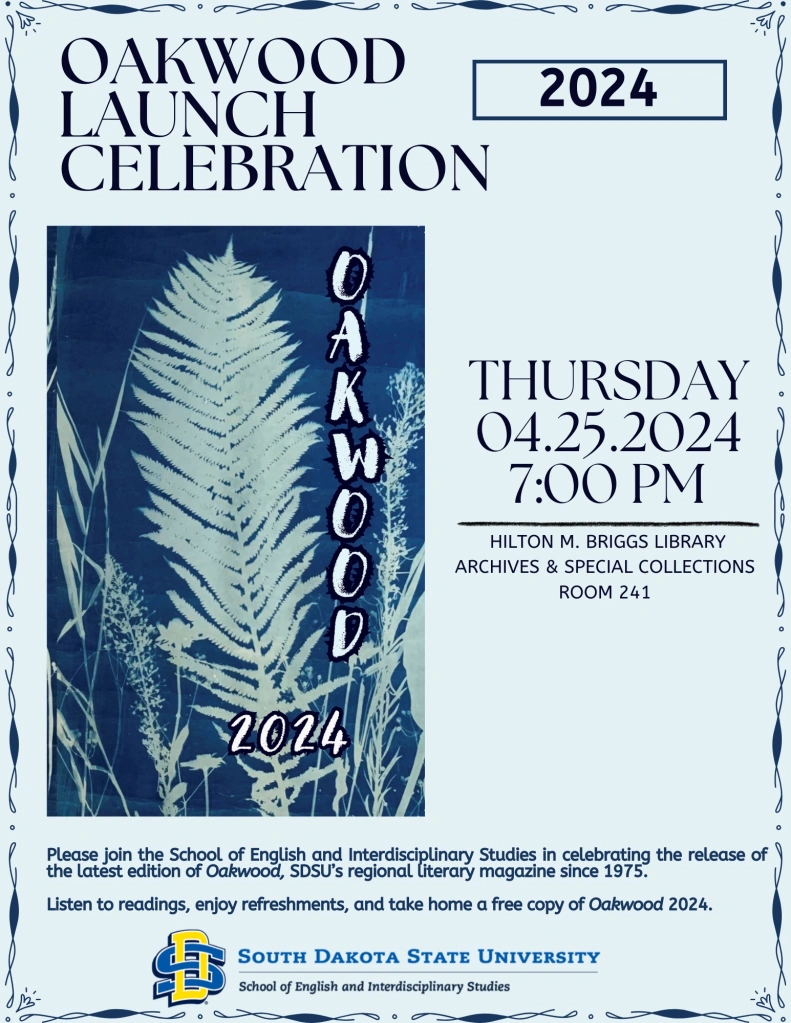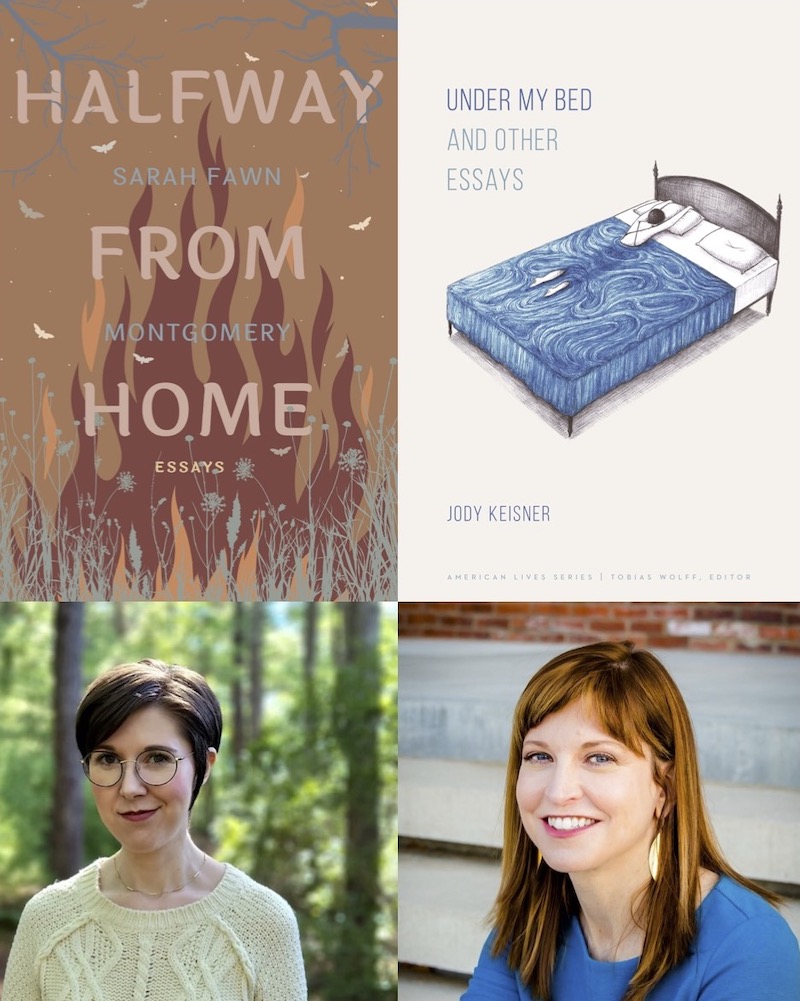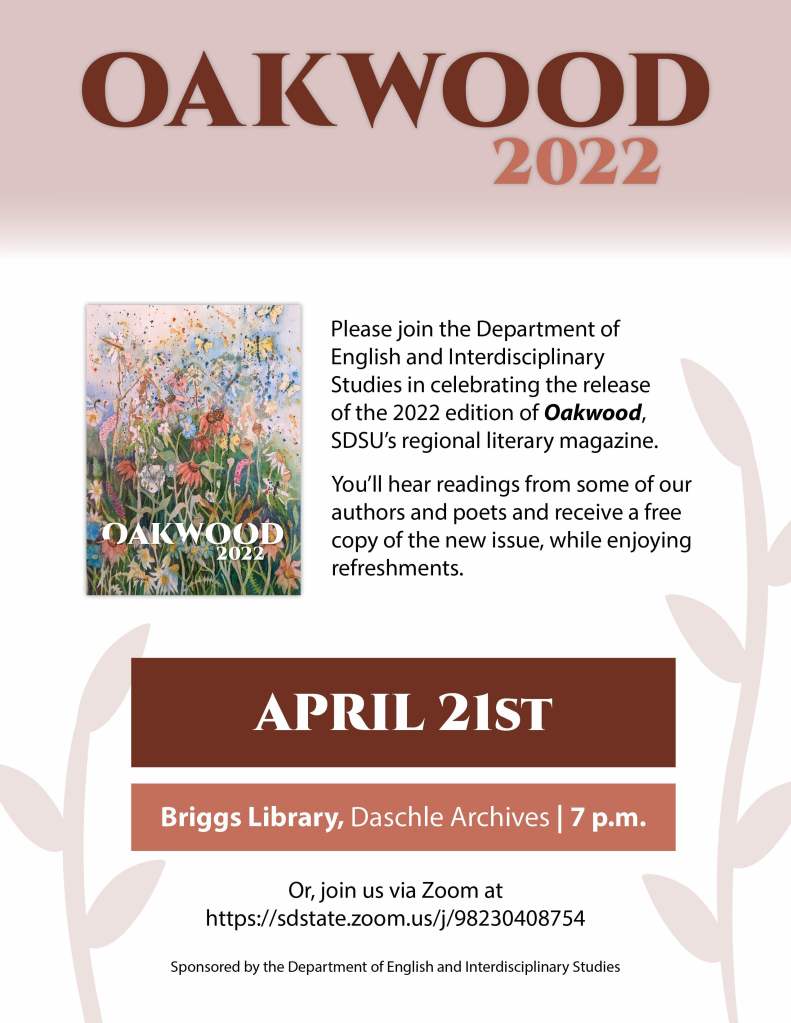We’ve got a new issue! Come see the launch, featuring many contributors, on Thursday April 25 at 7:00pm. Briggs Library, SDSU campus, Brookings, SD. Planet earth, Milky Way galaxy.

We have changed our submission period for our annual spring issue to September 1-December 31. Please see https://sdsuoakwood.com/submission-guidelines/ for full details. We look forward to seeing your work!
Oakwood is deep into editing and production on our 2023 print issue (due out in April), but we wanted to give you a preview: this conversation between two authors of the Great Plains about the Great Plains. Enjoy!

_______________________________
In prose that is as stunningly sensuous as it is sharply intellectual, Sarah Fawn Montgomery searches for home in her new essay collection, Halfway From Home. Braiding memoir with social and environmental criticism, Montgomery has written a lyrical love letter to her “dusty” California hometown, the “lonely” Massachusetts winters and New England woods, and the “quiet comfort” of Nebraska. Finding a home is not the same thing as finding solace, though, which seems impossible while the world is aflame with political and environmental upheaval, and a virus has sent nearly everyone indoors to isolate. She writes, “Everywhere was a throbbing hurt and I missed the homeland of my youth like I missed my actual home, neither of which existed anymore.” Yet, through her literal and metaphorical excavations of these geographies, Montgomery reveals that there is possibility for humanity’s reconnection and rebirth. Contemplating the prairie grass roots, she writes: “Hardy, unrelenting, their descent below should teach us something about survival and resistance, about working within a system rather than opposed to it, about looking to the past for succor and strength, to understand that what thrives is not simply what is easy.” In similarly wise, beautifully written passages Montgomery illustrates how nature has provided a guide for humanity’s path toward resilience and healing, if only we’re willing to follow.
Montgomery and I recently chatted through email about our shared Midwestern histories, mutual devotion to the geography and people of The Plains, and the parallels in our working-class origins.
Jody Keisner to Sarah Fawn Montgomery: Folks often equate the Midwest with small, rural, factory and farming towns and forget or ignore the fact that the Midwest has large urban cities, too. Can you talk about your experience of the Midwest? Is there such a thing as a Midwestern sensibility or humility? And how did either play into your most recent collection, Halfway From Home?
SFM: Halfway from Home is about my search for home across the West Coast, Midwest, and East Coast during emotional and environmental collapse, and the challenges of trying to find your place when human connection is disappearing and trying to live meaningfully when our sense of self is uncertain in a fractured world. When I first left my California home, I moved to Nebraska and found that the Midwest was entirely different than what I’d known on the West Coast, but also entirely different than what most media portrayed. Living in the Midwest for many years brought me to rural towns, but even more urban cities. I came across the quiet idyllic plains and old factories and farms that are often used to portray the Midwest as a place set back in time, but just as many bustling cosmopolitan places that defined the region as progressive. And these images and experiences varied widely from place to place—Kansas to Wisconsin, North to South Dakota, Minnesota to Indiana. Though close in distance, the Nebraska sandhills where cranes have returned to nest for millions of years and Red Cloud where there is a stretch of native prairie that has never been plowed are quite different from one another and vastly different from places like Lincoln or Omaha.
Learning to love a place—as I write about in Halfway from Home—requires deep work and humility. You must explore natural and human histories, the fossil record and soil strata, the many human hurts and hopes. You must learn about plant and animal species, how they survive in lean times as well as times of abundance. You must learn about weather patterns, about geology, about art history, about cartography. Living in Nebraska taught me lessons in humility because it is a place of contradictions and extremes—weather, seasons, social and political views, a place that is farther from the ocean than anywhere in the country yet was also once home to a Cretaceous sea. It is a place that does not care about human satisfaction or even survival. When you live in a place where the sky stretches up seemingly forever and the roots of prairie grass stretch unseen for miles underground, you have to accept your insignificance. It is easy to love and even claim popular tourist regions that exist, it seems, for human entertainment and ease, but the Midwest is not easy to love, and that complexity is precisely why it is such a rich region, and one that for me—no matter where I am from or where I go—has always felt like home.
SFM to JK: The essays in Under My Bed weave personal prose with thoughtful research about fear, anxiety, and the social and psychological impacts on women living with the constant threat of violence. Seamlessly blending personal stories of her Nebraska upbringing with cultural reflections on the impact of chronic stress on children, the hypervigilance of young women, and the ways motherhood impacts fear, Keisner questions “the distinction between reality and appearance” in order to examine where our terrors come from and how they shape us. Keisner’s panic is deeply rooted in place—the rural towns where she watched horror films as a child, the Omaha suburb where she discovered as a young girl that a serial killer had murdered children, and her working-class family that moved frequently and faced violence depending on her volatile father’s fluctuating employment. “I, too, worry that voicing my fear might summon it,” writes Keisner, yet she beckons these stories because “We carry on with true grit in the face of the knowledge that our bodies are predisposed to both wound and pain, for what choice do we have?” But though this collection is an examination of fear, it also offers hope. Keisner poignantly and powerfully probes worry and devotion, anxiety and empowerment, facing her many fears—intruders, a young aunt’s drowning, a life-changing diagnosis, raising her daughters—and revealing to readers that there are many things we can endure.
The Midwest is a central figure in this collection. How did place influence the writing in Under My Bed and Other Essays? How did it inform your fears?
JK: My formative years were spent frolicking on several acres of land near our earth home in Louisville, Nebraska, and later after we’d moved again, on my grandmother’s lake near the murky Platte River. Which is to say, I spent much of my childhood exploring the mysteries and pleasures of nature. It makes sense then that the natural elements intuitively became metaphors for exploring my greatest fears. For instance, water becomes a conduit for understanding my hypervigilant behavior as a new mother, afraid my newborn daughter will be hurt (or drown!) because of something I did wrong. Water, of course, is a natural symbol for the womb and motherhood in general. In another chapter, the wildfires in Spokane, Washington, where my parents had recently moved, provide the context for exploring the psychological firebreaks people build to form protective boundaries between themselves and what they’re most afraid of. And, the underground earth home where my family lived during some of the most tumultuous years of my childhood becomes a symbol for the trauma I buried in my brain only to have it manifest physically and mentally in my adulthood as both a chronic autoimmune disease and a mental illness. In Under My Bed, place represents different points of conflict in my life that have led to self-discovery.
JK to SFM: How do we transcend our identities–or the stereotypical identities others thrust upon us–as “Midwestern writers” into something more universal? Or should we even want to? Kristine Langley Mahler writes, “I’ve found the Nebraskan Midwessay to be goldenrod personified: understood only through its oppositional references while its author patiently undoes misconceptions.”
SFM: While I write nonfiction to share universal stories and struggles, individual identity is precisely why and how the reader connects. I am less interested in transcending identity than I am in embracing it, utilizing it to share with readers the rich regions about which I write, the dynamic places about which they might have static views. We write to claim space on the page, so it does not serve our stories or ourselves to write with the goal of changing people’s minds because that means our stories exist to serve those who do not value our identities. Instead, I write to claim my place on the page, to claim a place for Nebraska on the page, and in doing so, in being specific and honest about our experiences with this place and the many vibrant places of the Midwest, we will rewrite the stereotypical stories that have never served us, and replaced them with our authentic experiences.
SFM to JK: Your work is less about the geography of the Midwest than it is about the “rural” working-class people you were raised with. Why was it important for you to celebrate these people in your writing?
JK: I’m most interested in the geography of the people who raised me, as opposed to the geography of land. Symbols of a working-class life pepper my writing: my father and his grease-stained steel-toed work boots. The well water at my grandmother’s home that my mother complained smelled like rotten eggs. The Union Pacific locomotives painted with shields the color of the American flag. The septic tank buried inches from the snap peas in my grandmother’s garden and the sign above the toilet—If it’s Yellow, Let it Mellow. If it’s Brown, Flush it Down. Because the life my partner and I have built for our daughters is very different from my childhood—we live in the second-largest city in the Great Plains states—these details are not a part of my current life, so I remember and celebrate them in my writing. These symbols do a lot of the heavy lifting toward characterizing certain aspects of my family and where we’re from.
Ultimately, my intent is to contrast these outward signifiers of Midwestern, working-class life with nuanced stories that convey my family’s complex, rich inner lives. Yes, I’ve waited in an unemployment line with my father, and we wore cut-off jean shorts far too often at family gatherings. But underneath this, my family was far from fitting some mold for “Midwestern,” which has often translated into this notion of someone who is content with their lot in life, conservative, evangelical, and lives and works near cornfields or a factory. My grandmother, for instance, was an eccentric woman who had a deep understanding of reincarnation and made a study of “prophets” like Edgar Cayce. She was open-minded and progressive. She told me to never get myself into a situation where I had to rely financially on a man. She wouldn’t have used the word “feminist,” but she most certainly planted the ideals of feminism in my mind when I was very young. Another example, my father—a high-school dropout—became a poet at the railroad, saying things like, “Listen, and the train will tell you. I can close my eyes and feel what’s wrong with it.” People from the Midwest are as complicated as people who live anywhere else. Contrary to popular belief, we do not live a simpler life! Beyond that, I hope the stories I tell about Midwesterners illustrate universal truths that ultimately transcend place and economic class.
_______________________________
Jody Keisner is the author of Under My Bed and Other Essays (Sept. 2022). She is a writer, teacher, mother, first-generation college graduate, and ex-waitress. Her essays have appeared in Los Angeles Review of Books, Fourth Genre, Cimarron Review, Post Road, Brevity, VIDA Review, So to Speak, Brain,Child, Assay, Threepenny Review, Hunger Mountain, The Rumpus, The Normal School, Adroit Journal, Literary Mama, Hippocampus, Essay Daily, Women’s Studies, and many other literary journals and magazines. Her essay “Runaway Mother” is a notable Best American Essay 2022. She writes for AARP’s The Girlfriend, and is the Editor-in-Chief of The Linden Review, a journal of creative nonfiction focused on health. She is an Associate Professor at UNO, where she teaches creative nonfiction. She lives in Omaha with her family.
Sarah Fawn Montgomery is the author of Halfway from Home, forthcoming in November 2022 with Split/Lip Press. She is also the author of Quite Mad: An American Pharma Memoir (The Ohio State University Press, September 2018) and the poetry chapbooks Regenerate: Poems of Mad Women (Dancing Girl Press, 2017), Leaving Tracks: A Prairie Guide (Finishing Line Press, 2017), and The Astronaut Checks His Watch (Finishing Line Press, 2014). Her work has been listed as notable in Best American Essays for the last several years, and her poetry and prose have appeared in Brevity, Crab Orchard Review, DIAGRAM, Electric Literature, LitHub, New England Review, The Normal School, Passages North, Poetry Foundation, The Rumpus, Southeast Review, Terrain, and numerous other journals and anthologies. She holds an MFA in creative writing from California State University-Fresno and a PhD in English in creative writing from the University of Nebraska-Lincoln. She is an Assistant Professor at Bridgewater State University in Massachusetts.
Feel free to send us your literary and visual works between November 15, 2022 and February 15, 2023. Visit our Submission Guidelines for more information.
Hello, everyone. Oakwood is starting to rise from its summertime slumber and get ready to start building our 2023 issue, due out in April. We will be open for submissions from November 15, 2022 through February 15, 2023. Please check out our submission guidelines and get ready to send us what you’ve got!
We’ll be in person in Brookings, SD on Thursday, April 21 (7:00pm Briggs Library) and simultaneously running on the internet universe-wide at https://sdstate.zoom.us/j/98230408754. Hope you can join us!

We’ve gotten less art than usual this year, so we’re extending our submission deadline just a bit. Photos and visual representations of other media are welcome. We are particularly interested in seeing more black and white works. See our Submission Guidelines for more information.
After a long, covid-induced hiatus we are back in action and accepting submissions as of Monday, November 15. Please see our submission guidelines for more information. We’ll be looking at work for our 2022 issue (due out lat April) until February 15 and look forward to your literary and visual art submissions!